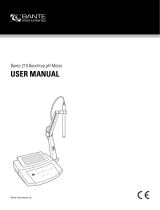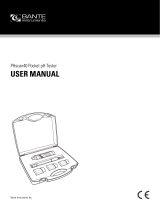
23
pH 210, pH 211, pH 212 and pH 213 are guaranteed for two years against
defects in workmanship and materials when used for their intended purpose and
maintained according to instructions. Electrodes and probes are guaranteed for
six months. This warranty is limited to repair or replacement free of charge.
Damage due to accidents, misuse, tampering or lack of prescribed maintenance
is not covered.
If service is required, contact the dealer from whom you purchased the instrument.
If under warranty, report the model number, date of purchase, serial number and
the nature of the problem. If the repair is not covered by the warranty, you will be
notified of the charges incurred. If the instrument is to be returned to Hanna Instru-
ments, first obtain a Returned Goods Authorization number from the Technical
Service department and then send it with shipping costs prepaid. When shipping
any instrument, make sure it is properly packed for complete protection. The Hanna pH 210, pH 211, pH 212 and pH 213 are microprocessor-
based pH and Temperature bench meters.
pH 211 and pH 213 can also measure ion concentration (ISE) and
Oxidation Reduction Potential (ORP) in the mV range.
pH measurements are compensated for temperature effect manually or
automatically with the HI 7669/2W temperature probe.
The instrument is equipped with a large easy-to-read LCD which shows
the pH (or mV) and temperature simultaneously, together with graphic
symbols.
The calibration process is guided step by step through clear indications on
the LCD. A stability indicator makes the calibration procedure error-free.
Through the RS232 serial port data can be transferred to a PC
(pH 212 and pH 213 only).
Remove the instrument from the packing material and examine it
carefully to make sure that no damage has occurred during shipping.
If there is any damage, notify your Dealer or the nearest Hanna
Customer Service Center.
Each instrument is supplied with:
•HI 1131B Glass-body Combination pH Electrode
•HI 7669/2W Temperature Probe
•HI 76404 Electrode Holder
•pH 4.01 & 7.01 Buffer Solutions, 20 mL each
•HI 7071S Electrolyte Solution
• 12VDC Power Adapter
• Instruction Manual
Note: Save all packing material until you are sure that the
instrument functions correctly. All defective items must be
returned in the original packing with the supplied accessories.
WARRANTY .................................................................................. 2
PRELIMINARY EXAMINATION ........................................................ 3
GENERAL DESCRIPTION ................................................................ 3
FUNCTIONAL DESCRIPTION pH 210 AND pH 211......................... 4
pH 210 AND pH 211 SPECIFICATIONS ........................................ 5
FUNCTIONAL DESCRIPTION pH 212 AND pH 213......................... 6
pH 212 AND pH 213 SPECIFICATIONS ........................................ 7
OPERATIONAL GUIDE ................................................................... 8
pH CALIBRATION ....................................................................... 11
TEMPERATURE CALIBRATION (for technical personnel only)........... 14
mV CALIBRATION (pH 213 only) (for technical personnel only) .... 16
PC INTERFACE (pH 212 & pH 213 only) .................................... 17
pH BUFFER TEMPERATURE DEPENDENCE...................................... 19
ELECTRODE CONDITIONING & MAINTENANCE............................... 20
TROUBLESHOOTING GUIDE ........................................................ 23
TEMPERATURE CORRELATION FOR pH SENSITIVE GLASS ................. 24
ACCESSORIES ............................................................................. 25
TABLE OF CONTENTSTABLE OF CONTENTS
TABLE OF CONTENTSTABLE OF CONTENTS
TABLE OF CONTENTS
Dear Customer,
Thank you for choosing a Hanna Instruments product.
Please read this instruction manual carefully before using the instruments.
This manual will provide you with the necessary information for correct use of
the instruments, as well as a precise idea of their versatility.
If you need additional technical information, do not hesitate to e-mail us at
These instruments are in compliance with directives.
WARRANTYWARRANTY
WARRANTYWARRANTY
WARRANTY
PRELIMINARY EXAMINATIONPRELIMINARY EXAMINATION
PRELIMINARY EXAMINATIONPRELIMINARY EXAMINATION
PRELIMINARY EXAMINATION
GENERAL DESCRIPTIONGENERAL DESCRIPTION
GENERAL DESCRIPTIONGENERAL DESCRIPTION
GENERAL DESCRIPTION
Hanna Instruments reserves the right to modify the design,
construction and appearance of its products without advance notice.



















